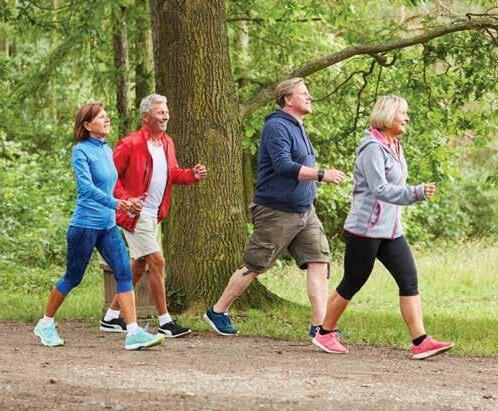
4 minute read
fit body
Spirited Strides
POWER WALK TO BETTER FITNESS
by Marlaina Donato
We all know that the more steps we take in a day the better. The Mayo Clinic advocates walking regularly to keep bad cholesterol in check, maintain a heart-healthy weight and keep blood pressure within a normal range. Power walking—going a mile in under 15 minutes—amps up cardiovascular benefits and takes metabolic conditioning to a new level.
Power walking involves taking longer strides, moving at 4.5 to 5.5 miles per hour and using the arms to propel motion, with or without light weights. “With this more intensive exercise, in comparison to everyday walking, one should note that their breathing is harder and their heart rate is faster with power walking. Compared to someone who walks at a casual pace, a power walker can expect lower blood pressure, heart rate, blood sugar and cholesterol numbers,” says Jason C. Robin, M.D., director of cardio oncology at North Shore University Health System, in Glenview, Illinois.
Walking as a Workout
In cases of severe coronary artery disease, certain heart muscle disorders, known as cardiomyopathy or valvular diseases, Robin recommends seeing a doctor before taking up fitness walking, but emphasizes,

For centuries, people have used chaga mushrooms for medicinal purposes. Packed with antioxidants, its extract may fight cancer, chronic inflammation, improve blood sugar and cholesterol levels. Order your Immune-Boosting Superfood today!
Call 906-282-0787 Now! We make 100% all natural products for helping and promoting better health and skin. We have several doctors who not only carry our products but use them as well. We are state certified, state inspected, and THE ONLY Chaga facility licensed in the U.P.

MidnightSpcl_59@yahoo.com • UPChagaConnection.com
“Obvious injuries or illnesses aside, power walking is great for all ages, genders, sizes and fitness levels and is, in general, very safe with very few contraindications.” He suggests aiming for 15 minutes or less on a first endeavor, and after one week increasing the time to 20 to 25 minutes, eventually working up to 30 minutes. To complement power walking, he recommends resistance training to increase muscle strength and tone, protect joints from injury, and improve flexibility and balance.
Dave McGovern, walking coach and author of The Complete Guide to Competitive Walking: Racewalking, Power Walking, Nordic Walking and More!, points out, “The impact forces of walking, even high-level racewalking, can be one-third of what runners experience, so it’s a lot easier on the joints. Power walking doesn’t have many rules.” A 30-year veteran of the U.S. National Racewalk Team, McGovern underscores the importance of starting out with a regular, easy walk before progressing to a more vigorous pace.
To avoid and reduce injury, he advocates mindfulness of correct posture and taking shorter, faster steps rather than long, stomping strides. He trains on a variety of surfaces, including everyday roads, tartan (rubber) running tracks, treadmills, dirt trails, grass, and even the occasional concrete sidewalk. “Changing up surfaces uses your muscles in different ways, which can help prevent overuse injuries that crop up from too much training on the same surfaces day in, day out,” he says.
Practical Essentials
For optimal results on any surface, proper footwear is vital. “We would typically recommend a running shoe for any fitness-based walking,” says Josh Saint Cyr, store manager at New Balance, in Highland Park, Illinois. He notes that the right shoes are designed to help align gait and avoid pronation or supination that prompts the ankle to roll inward or outward with movement. “For a more customized experience, someone with medium or lower arches would want a shoe from the stability running section, and someone with higher arches would want a shoe from the cushioned running section.”
In cases of tight calf muscles, Saint Cyr recommends stretching as a daily practice, even on non-exercise days. “Rollers or massage guns can be useful for immediate relief, but ultimately, stretching will help by reducing or eliminating tightness.”
Taking it Up a Notch
Racewalking, the competitive and highly technical variety of power walking, takes place at track meets. “After you’ve built a base of miles, you can start sprinkling in some longer and faster workouts, and maybe even think about competition,” says McGovern. “There is a bit more technique involved in competitive racewalking, but once you get the hang of it, it will allow you to go much faster.”
In the end, having a goal can be the best motivator. “For the athletes I coach, many of them in their 50s, 60s, 70s, 80s and beyond, racewalking and power walking gives a purpose to their workouts,” says McGovern. “One of my athletes has said that she hates to work out, but loves to train. Having the goal of a race over the horizon gives a lot of athletes a reason to get out the door every day.”
Marlaina Donato is an author and composer. Connect at WildflowerLady.com.











